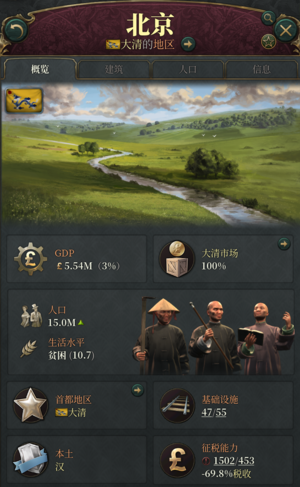地区是维多利亚3中主要的政治地理“单元”,人群在地区中生活同时建筑被
建设在地区之中。
地理地区与行政地区
一个地区通常是被唯一一个国家控制的,且地区的边界是动态的(可以在游戏过程中被改变,包括创建和摧毁)。值得一提的是一个地区(地理意义上)中支持出现一个或数个“地区”(国家省份划分层面上)。如果一个国家拥有一个地区(地理意义)的全部区域,这两者是没有什么区别的,但如果不止一个国家在这个地区(地理意义)中拥有一定的小地块,那么他们将分别拥有属于自己的分属地区。
例如,莱茵兰地区是法国边境上的一组预先确定的省份,在1836年时包含两个地区:普鲁士莱茵兰(实际上被称为莱茵兰,因为它占据了一半以上该地区的土地)和巴伐利亚莱茵兰(被称为巴伐利亚莱茵兰以与普鲁士所占据的部分区分开),这被成为分属地区。在游戏进行中,莱茵兰地区的整体形状永远不会发生改变,但是其中的各地区可能发生改变。如果法国征服了普鲁士莱茵兰,显然将不会存在普鲁士莱茵兰,而会变为法兰西莱茵兰。而如果普鲁士征服了巴伐利亚莱茵兰,则整个地区会被统一成为一个普鲁士的地区。
战略区域
战略区域是一个由多个地区组成的大型预定地理区域。目前游戏中内建的617个地区共被分为53个战略区域。
地区状态
整合状态
除了政治上的归属,还有一些条件可以地区的人口和经济。首先是整合状态,用于表明该地区在拥有其的国家内处于怎样的政治状态。以下是不同的整合状态。
- 已整合地区:指该地区已经作为一个政治单元完全融入国家。该地区消耗完整的行政力,支付政府要求的所有形式的税收,并从所有国家机构中受益。
- 未整合地区:指该地区由国家拥有,但只接受轻度的管理,例如边境地区。未整合地区不消耗任何行政力,但仅支付特定种类的税收(例如消费税),不会从国家机构中受益,同时会受到基础设施减益。
- 殖民地地区:指该地区被认为是海外殖民地。运行方式类似于一个未整合地区,但会以较低的基础设施为代价获得更多的移民。
只要你有足够的行政力能对地区进行有效管理,你就可以整合一个未整合/殖民地地区。但这可能是一个艰难的过程——虽然管理成本会立刻支出,但收益(税收,机构及其它)只能随着时间逐渐获得。整合时间取决于你的国家接受当地人的难易程度——例如,大不列颠整合一个印度地区将比整合福克兰群岛困难得多。
地区状态
其它地区可能获得的状态包括(并非详尽列表):
- 首都:国家的政治中心。所有居住在首都的人群将会获得更强的政治力量。
- 市场中心:国家的经济中心。会获得额外的基础设施和移民吸引力。
- 动乱:A state that has too many political radicals (as a percentage of population) will experience Turmoil. A state with Turmoil suffers penalties in the form of increased Tax Waste and reduced Migration Attraction. These penalties can be reduced by investing into the Police institution.
Inherited conditions
- 参见:State traits
States can also inherit certain conditions from their state regions, including:
- state traits: As explained in the Infrastructure dev diary, these represent a wide variety of geographical features that have an impact on the economy, infrastructure and/or population of the entire state region.
- Claims: A state region can be claimed by a country that does not currently own it but are broadly considered to have a legitimate reason to think that maybe they should. We'll come back to this when talking about diplomacy and war.
- Homelands: Every Culture has one or more state regions that most people in that Culture consider to be their natural homeland. This does not consider the views of anyone else outside that Culture (ie, the Swedes don't get any say in which state regions the Russians consider to be their homelands and vice versa), and has certain effects that we will go over in later dev diaries.
Resources within States
States are limited in which Resource Industry Building Types they can support and how large these can get. For example, the degree of Iron deposits in a state limits how many levels of Iron Mine you can build there. These resource limits are actually a property of state regions, which is dynamically allocated to the states in the region based on how large of a share the state holds.
It's worth noting that this proportion isn't just based on the raw number of provinces owned. As an example, potential for Fisheries are distributed according to the amount of coastline a state has in the state region, while Arable Land land can be heavily weighted by the amount of Prime Land is in each state. While not applicable everywhere, Prime Land is something we use in states where there is a clear division between fertile and non-fertile land - control of the Nile should matter a lot more to a state in Upper Egypt's Arable Land than control of the surrounding desert, for example.
It's also possible for a state region to contain discoverable resources. These are resources such as Oil, Gold or Rubber that are either not known about or not considered exploitable at the start of the game, but may be discovered and exploited at a later point. Certain technologies will affect both which resources can be discovered and the actual chance of said resource being discovered. All of this functions in a weighted random fashion, so while the chance of there being a Klondike gold rush at some point during the game is high, it probably won't happen exactly at the same date it did historically.
